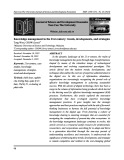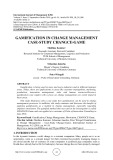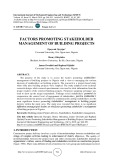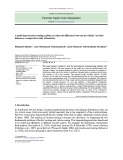
http://www.iaeme.com/IJM/index.asp 112 editor@iaeme.com
International Journal of Management (IJM)
Volume 9, Issue 2, March–April 2018, pp. 112–122, Article ID: IJM_09_02_013
Available online at
http://www.iaeme.com/ijm/issues.asp?JType=IJM&VType=9&IType=2
Journal Impact Factor (2016): 8.1920 (Calculated by GISI) www.jifactor.com
ISSN Print: 0976-6502 and ISSN Online: 0976-6510
© IAEME Publication
OPTIMAL CRASHING TIME SCHEDULING FOR
MEGA PROJECTS
Rami A. Maher
Isra University Amman, Jordan
Ibrahim Abed Mohammad
Isra University Amman, Jordan
Hamzeh H. Al-Safadi
Isra University Amman, Jordan
ABSTRACT
This Paper presents a framework for time crashing a mega project by using the
linear programming technique such to earned least total crashing cost. First, a
mathematical model of the problem is given, and then after a numerical example is
introduced to demonstrate the efficiency of this technique in solving the time crashing
problem of mega projects for different time crashing values. This will help the project
managers to consider strategic decisions for crashing the milestones and activities
constituting the mega project.
Key words: Crashing Scheduling, Linear Programming, Mega Projects, Milestones
Cite this Article: Rami A. Maher, Ibrahim Abed Mohammad and Hamzeh H. Al-
Safadi, Optimal Crashing Time Scheduling for Mega Projects, Practices and
Management, International Journal of Management, 9 (2), 2018, pp. 112–122.
http://www.iaeme.com/IJM/issues.asp?JType=IJM&VType=9&IType=2
1. INTRODUCTION
Mega project composed from two words “Mega” and “Project”, the word Project which
identified as temporary endeavor undertaken to create a unique product, result or service [1].
Meanwhile, the word “Mega” is to determine that something is very huge. Thus, mega
projects are temporary endeavor undertaken characterized by large investment, vast
complexity (especially in organizational terms), and long lasting impact on the economy,
environment and society [2]. Mega project includes airports, power plants, tunnels, large-scale
sporting events and natural gas extraction that are examples from very wide number of mega
projects.
As a general rule of thumb “ Mega projects” are measured in billions of dollars , “ Major
projects” in hundreds of millions and “Project” in millions and tens of millions [3]. One of the

Optimal Crashing Time Scheduling for Mega Projects
http://www.iaeme.com/IJM/index.asp 113 editor@iaeme.com
most important properties is that the mega project cannot be delivered on time because of the
complexity and huge number of activities that should be considered by the manager.
The question arias now is what is Mega project ? To answer this question many dimension
must be discussed. For instance, from investment point of view, projects have capital cost
more than 1$ billion dollars are considered as mega projects [4]. The problem with mega
projects is the frequent failure of many of these projects. For example, Analyzing a dataset of
318 industrial mega project shows that 65% of them are classified as failure [5]. Another
example, Oil and gas production sector is the worst, where 78% of the mega projects
categorized in failure area. A major cause of this failure is that the actual costs of these project
are higher than estimated costs and actual implementation schedule was higher than estimated
schedule[6]. Van Merrewijk et al. define mega project as “multibillion-dollar mega
infrastructure usually commissioned by government and delivered by privet enterprise; and
characterized as uncertain, complex, politically- sensitive and involving large number of
parties [7].
In what follows in this introduction, some fundamental concepts will be introduced. In
general Project management is the discipline of initiating, planning, executing, controlling
and closing the work of team to achieve specific goals and meet specific success criteria.
Project in general consist from activities which identified as smallest identifiable and
measurable piece of works can planned and managed. Activities start with events and end
with events. There are several methods to represent projects activities used such as the activity
on arrow AOA and activity on node AON. For project scheduling two analytical approach are
usually used; the critical path method CPM and project evaluation and review technique
PERT. The major different between these two approach is that the PERT technique utilizes
uncertainty to develop activities duration.
One important process in project management issue is the analysis of possible time-
crashing for an assumed additional resources. Project crashing and cost law optimization
generally was studied in several times to add new information to existing body of knowledge,
these study developed for determining the least scheduling deadline for the project with least
costly crashing schedule to make optimum solution [8]. The simulation approach for
optimization project cost and schedule is one of tools that can be used to bring back the
project under control. The simulation approach consists a collaboration between project
manager and IT department in company to make optimum scheduling time and cost overruns.
The optimization of time and cost process could be considered as standard process for each
project separately; the time spent on the actual crashing was minimal and the project
scheduling time must be reduced to the minimum level of the optimization of saving money
and time [9].
Linear Programming (also called linear optimization) is a special technique from
mathematical optimization that aims to achieve best outcomes in minimal or maximal sense
from a linear relationship of many variables that are simultaneously subjected to linear
equalities and/ or inequalities constraints. The linear programming technique has been used
efficiently to solve several problems in project management including the crashing problem,
[10].
This paper is devoted to give and illustrate a methodology of optimal time crashing of a
mega project by utilizing the analysis of milestones characteristics and linear programming
technique.

Rami A. Maher, Ibrahim Abed Mohammad and Hamzeh H. Al-Safadi
http://www.iaeme.com/IJM/index.asp 114 editor@iaeme.com
2. PROBLEM STATEMENT
Let a certain mega project consists of milestones whose time interrelationship network is
given, and that the normal completion time of the mega project is already calculated
together with one set of critical activities, i.e. a single critical path. Furthermore, each
milestone has its predecessor list of activities, normal duration , normal cost , and the
crashed duration and corresponding crashed cost of each activity. It may be the case
that some activities within the milestones cannot be crashed; i.e. they have a crashed duration
equal to the normal duration. Consequently, the crashing slop for each critical activity
within each milestone is calculated from the following relation
The task is to crash the mega project to a certain completion time less than by a
specified amount of units of time, say with minimum additional cost (additional resources).
The amount of crashing can be obtained either from a specific subset of the critical milestones
or from the addition of possible individual crashing time amounts from each critical
milestones. obviously, this will depends on the original scheduling of the mage project itself.
3. METHODOLOGY AND MODELING
The scheduling analysis of a mega project requires a general software tool to deal with
different tasks within the solution framework of the scheduling process. It is known that most
scheduling operations desire the activity network of each milestone, i.e. to have the AOA
network. This facilitates the use of the mathematical optimization efficiently. Therefore, the
first step is to obtain the time matrix and the number identifier matrix of activities of each
milestone. These two matrices are given by the following definitions
{
{
An algorithm that performs the generation of these two matrices directly from the given
predecessor list of activities can found in [11]. The next step is to determine the critical path
value and the activities along this path . One efficient method to do that is to utilize
Floyd's algorithm [12] with some simple modifications. This algorithm provides also the
earliest starting time and the latest starting time and consequently the free and the total floats
for each activity [13]. Next, the crashing slops are computed and stored in corresponding to
each activity. These three steps are performed for all milestones of the considered mega
project. Finally, the possible largest crashing time of each milestone will be obtained,
where
∑
where is the number of the critical activities in the milestone (excluding any critical
activity that it cannot be crashed for any reason). Noting that in case of multi critical path
problem, for primary investigation, the crashing calculation should consider only the critical
activities that are common for all critical paths.
Then the maximum possible crashing time of the mega project is given by

Optimal Crashing Time Scheduling for Mega Projects
http://www.iaeme.com/IJM/index.asp 115 editor@iaeme.com
∑
Consequently, the required corresponding maximum additional cost that perform
the can be calculated.
Now if , then the manager has no choices but only to consider the above
calculations, and crashing individually each milestone . However, if then the
manager will have multi choices for achieving the desired crashed completion time of the
considered mega project. For the latter case, the linear programming model is proved to be a
suitable technique for obtaining optimal results of such a task.
The linear programming model for the crashing problem can be stated as follows:
1. Define a set of variables to denote of the amount of units of time that each activity
will be crashed, where . In addition,
another set of variables has to defined; it contains the starting times of
activities, . The starting time of this activity is computed from
2. To define the cost function to be minimized, i.e.
∑
where is the crashing slop associated with activity.
3. To define a set of constraints including crashing time constraints, nonnegative
constraints, and unfolding the network constraints (every activity should be start after
preceding activity completely finished); these are defined as
( )
( )
where are linear relations of starting time of network activities, is a number depends
on the predecessor list of the project, and are time values conducted from the normal
duration of the network.
The methodology of applying the linear programming technique for an optimal crashing
time of a mega project will be performed in two phases. In the first stage, the mega project
network will be analyzed to obtain the optimal amount of crashing time that should taken
from the completion time of each critical milestone, then, in the second phase, these amounts
are optimally distributed for crashing the critical activities of each milestone.
4. SIMULATION AND RESULTS
For illustrating the methodology of the time crashing problem of mega projects, a simple five
milestones mega project will be considered. The network of the project is very simple, it is
just a sequential series of the five milestones; this simply means that the all milestones are on
the critical path and the completion time is simply the addition of durations.

Rami A. Maher, Ibrahim Abed Mohammad and Hamzeh H. Al-Safadi
http://www.iaeme.com/IJM/index.asp 116 editor@iaeme.com
Table 1 summarizes the initial data of these milestones including the normal completion
time (duration) and the total required normal cost of each milestone.
Table 1 Initial data of milestones
Milestone
Name
Number of
activity
Normal
Duration
(days)
Normal Cost
$
22
248
1406900
20
220
1208600
48
300
3326250
50
340
4035176
60
400
4100735
Then the total normal completion time of the mega project is equal to 1508 days and a
total normal cost equal to 13,977,661 $.
As a sample of computation, milestone
will be considered; it has an activity on node network AON shown in figure 1, and a
predecessor list given in table 2. As it can be noted that activities
cannot be crashed for some reasons. In table 2, it is also given the
possible crashing duration of each activity and the crashing cost to perform the crashing.
Figure 1 Activity network of milestone
The information in table 2 is used to calculate the crashing slop associated with each
activity. However, it can be shown easily that milestone has six critical paths, and for a
certain time crashing, such characteristic should be considered carefully.
Table 3 gives the crashing time in days, the crashing slops, one of the possible critical
path. However, the maximum possible crashing time of this milestone is equal to 20
days; common critical activities are only considered. In similar way, the same information can
be obtained for all other milestones of the considered mega project. Table 4 summarizes these
calculation for each milestones. From data of table 4, it can be concluded that is 20
days and that sums 128 days as a possible maximum value of crashing time.



















![20 câu hỏi Quản lý dự án phần mềm có đáp án [mới nhất]](https://cdn.tailieu.vn/images/document/thumbnail/2025/20251003/hieu2004haha@gmail.com/135x160/78791759734259.jpg)


![Tài liệu Quản lý dự án: Kiến thức nền tảng toàn diện [chuẩn SEO]](https://cdn.tailieu.vn/images/document/thumbnail/2025/20250910/kimphuong1001/135x160/92631757496585.jpg)



